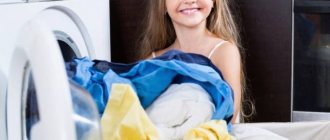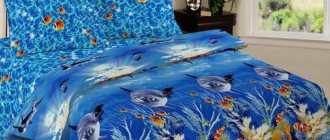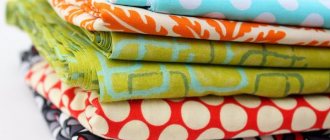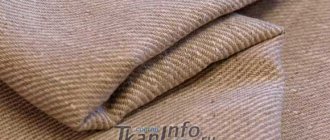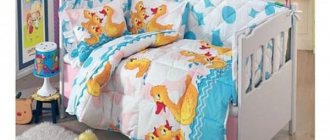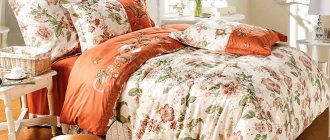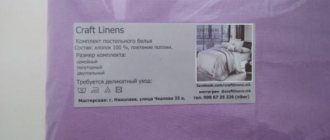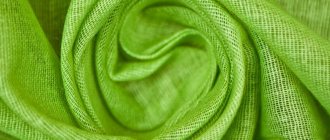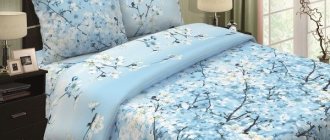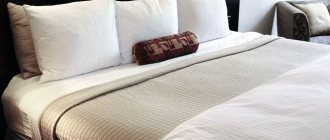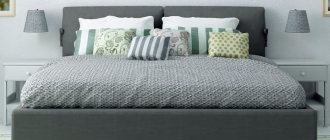View other posts Not everyone knows why it is so important to choose good fabric for children's bedding. It would seem - how should children's bedding differ from adult bedding? Is it just funny cartoon pictures? But the situation is somewhat more complicated, and we will now figure out what to pay attention to when choosing.
Every parent has tried at least once to put their child to sleep. And not every very responsible and prepared father is able to withstand these hours-long rituals. Children have difficulty switching from daytime activity to the peace of rest: this is hampered by a lack of fresh air or unspent energy, noisy games before bed, overexcitation from new experiences, and if the sheet is hard or it’s hot under the blanket, then with the dream of a peaceful fall asleep ( and a quiet hour with your wife and tea in front of your favorite TV series) you can immediately say goodbye.
Bed linen is one of the powerful factors of good rest. Remember: you yourself have repeatedly suffered, tossing and turning on a lumpy sheet on a stuffy summer night. Therefore, children also need to select bedding - according to the season and age, and not just according to the characters of their favorite cartoons.
Characteristics of children's fabrics
To arrange a children's bed, you should select high-quality materials. They must meet basic requirements.
- Be safe for the baby. Bedding should not emit harmful substances that can lead to dermatitis, allergic rashes, itchy skin and other problems. In the manufacture of such materials, chemically “aggressive” dyes should not be used.
- Possess hygroscopicity. Children often sweat during night or daytime sleep, so bedding fabric should absorb excess moisture well and dry quickly.
- Good air flow. Natural circulation will allow the skin to “breathe”, thereby creating favorable conditions for quality rest.
- Contribute to the absence of static accumulation.
- Differ in color fastness. Sometimes it happens that patterns from colorful and bright fabrics remain on the child’s skin after sleep. This shouldn't happen.
- Be comfortable. The bedding material should create a pleasant tactile sensation when in contact with the body.
- Have sufficient strength and wear resistance. The fact is that bedding in a child’s crib gets dirty much more often than in an adult’s. Therefore, it is important that the material can withstand more than a dozen washes while maintaining its original qualities.
- Easy to care for. This is an optional criterion. However, any parent will appreciate it if the fabric is easy to wash, dry quickly and smooth out without much effort.
An important selection criterion is the appearance of the fabric. Before falling asleep, many children look at the pictures on the duvet cover, pillowcase or sheet. Therefore, images on bedding should be unobtrusive, but attractive to children.
What fabrics are children's bedding made from?
Let us note right away that a child’s skin is more delicate than that of an adult, even if the child is a hyperactive fidget with always scratched hands and knocked-out knees. This means you need soft bed linen. Even ordinary calico is not suitable for everyone - and adults love to bask in something smooth and soft, but what about the baby? Fortunately, the modern textile industry offers dozens of different fabrics for children's bedding. But we will not consider everything, but will take only the most common ones.
Calico Poplin
Calico . Plain traditional material. Inexpensive and practical. Hygienic and hypoallergenic. Its only downside is that it can be a bit harsh for the little ones.
Poplin . A softer fabric than calico, just as practical and durable, absorbs moisture well and retains heat. This is probably the best fabric for baby bedding.
Percale Satin
Percale . A thinner, denser fabric than calico or poplin, it feels smooth and silky to the touch. One of the strongest and most durable materials. The main disadvantage is that it wrinkles a lot.
Satin . The fabric rightly belongs to the elite. Smooth and durable, casts a noble shine. But many believe that teaching children from an early age to luxury is dangerous.
Bike Bamboo
Tale . Very soft and delicate material with double-sided pile. Absorbs moisture perfectly and is very warm. Not suitable for hot summer.
Bamboo . A relatively new material made from recycled cellulose. In many respects it is better than cotton fabrics, but many are put off by its artificial origin.
Ranfors
Ranfors . In fact, this is a version of improved calico. It is produced in exactly the same way as calico, only from thinner fibers of improved quality. Thinner and denser, softer than calico, but essentially the same.
Considering the above, you can easily choose bed linen from the fabric that best suits its characteristics.
Choosing a sheet
A sheet is a rectangular piece of fabric that covers a mattress. This type of textile wears out quite quickly because it experiences more friction and withstands pressure. The sheet most often needs to be washed.
There are several types of sheets:
- An ordinary piece of fabric, processed on all four sides, is simply used to cover the mattress. It’s good if this item is larger than the size of the bed, so that all the edges can be tucked under the mattress - this way the sheet will hold well and will not bunch up or slide off.
- A sheet with an elastic band is ideal for a child's room. The product is very easy to attach to the bed thanks to the elastic tape that is sewn around the perimeter. The elastic prevents the sheet from coming off, and the child sleeps peacefully.
- A Velcro sheet is also a good option for a child's bed. However, be careful - Velcro clings to all fabrics during washing, but they perform their function - to stay on the bed - perfectly.
Standard bed sheet sizes:
- 110x150 cm (nursery bed);
- 120x150 cm (standard);
- 150x220 cm (schoolchildren and teenagers).
Sometimes fabrics for children's underwear are treated with special impregnations. If necessary, you can find not only antibacterial kits, but also products with waterproof treatment.
Colors
When choosing a set of bed linen or fabric for a duvet cover, pillowcase or sheet, you should consider its color. Scientists have long proven that colors can influence a child’s psyche, mood and behavior.
When purchasing fabric for a baby's crib, it is better to choose products in soft pastel colors. White and milky shades will help calm and relax the child, ensuring that he quickly goes to sleep. Pale blue, soft pink and beige tones of bed linen will also “help you sleep.” It is important to note that the accessories should not have numerous bright images. It is better that the number of pictures is limited and their colors are light.
Bright colors such as green, red, orange, blue can energize children and give them energy. Due to these features, bedding with such shades is recommended for use in the beds of children who are already beginning to show interest in games.
When choosing fabric for a children's sleeping set, you should avoid purchasing materials in dark colors. Blue, black, purple, dark brown colors will cause a child to feel anxious.
Bed linen of such colors will not allow the baby to relax and fall asleep quickly.
Color selection
This criterion depends on the age of the child, his preferences and, of course, on the design of the room.
We should not forget about the psychological state of the baby, because many psychologists note that it directly depends on the colors surrounding the child. So what color should you choose for children's bedding?
It is worth giving preference to calm, natural colors. You should not choose popular “acid tones”, but on the contrary, it is better to take time-tested classics - soft blue, green, light green, beige, light pink, etc. They are unobtrusive and pleasing to the eye. Let's take a closer look at a few:
- Blue tones are suitable for active children. They help you relax and relieve emotional stress that accumulates throughout the day.
- Bed linen in light brown shades, for example, beige, baked milk, chocolate, caramel, etc. will help improve your baby's appetite.
- Yellow color will stimulate the child to curiosity, invigorate and improve his mood.
- Green color will create a pleasant and relaxing atmosphere. This is a natural color that is comfortable for our eyes, so in a room with green tones the baby will calm down and quickly get ready to relax.
- Please note that many experts recommend avoiding dark shades. They will have a depressing effect on the child’s psyche. Too bright colors, on the contrary, will contribute to overstimulation of the child’s psyche.
Pillowcase for healthy sleep
The pillowcase should be chosen carefully so that it does not compress or deform the pillow.
Choosing the perfect pillow for your baby is not easy. The pillowcase should adequately complement the bedding, protect the product, be pleasant when in contact with the skin of the face, be easy to wash, and also have a comfortable design. It is important that the pillowcase can be easily removed and put on. High-quality material does not fade, absorbs moisture well, allows air to pass through and does not allow the filler to break through the weave of the threads.
Types of children's pillowcases:
- with a smell (most often found among standard ready-made kits);
- in Oxford style (with “ears”, that is, with textile fringe);
- with a zipper (a very durable and reliable way to hold the pillow inside the pillowcase);
- on buttons and buttons (the design is very good, but the zipper can be closed in one movement, but the buttons and buttons will have to be carefully fastened one after another).
When purchasing, make sure that all accessories are safe, that the buttons hold well, and that the metal zipper will not scratch you. If you are worried, feel free to purchase a regular scented pillowcase - this is an absolutely safe product.
Standard children's pillowcases come in two types: square and round. Main dimensions:
- 40x60 cm;
- 35x45 cm (Euro size);
- 70x70;
- 50x70.
When purchasing a set of bed linen, make sure that all the fittings work, all machine stitches are straight, and the product itself does not have a chemical smell. Under no circumstances should traces of dye remain on your hands - you should absolutely not buy such underwear.
Correct head position during sleep is very important for health. A comfortable posture, relaxed muscles - all this prevents the development of various diseases. Choose your pillowcase carefully so that it does not compress or deform the pillow due to the wrong size.
This is interesting: Children's pillows: for sleeping, orthopedic. Which ones to choose and buy?
What are the main criteria for choosing fabric for children's bedding?
Naturalness.
On the one hand, no one in their right mind would choose synthetics for a child (or even for themselves). Anyone would prefer fabric made from natural fibers. But, on the other hand, not everyone knows that GOSTs allow the names “pure cotton” and “pure wool” for fabrics in which the share of synthetic fibers can reach up to 10% (and for wool and more). But our native Russian standards in this regard are stricter than the technical conditions of the southern and eastern countries-which-are-not-accepted-to-be-named. Therefore, when our (serious) manufacturers write “100% cotton” on their bed linen, you can usually trust them.
Hypoallergenic.
When describing the fabrics used for sewing children's bedding, we mean only natural fabrics. Cotton fabrics (calico, poplin, percale) are least likely to cause allergies. They are the safest for a child and therefore when choosing bedding you need to pay attention to the composition: it should not contain synthetics. Linen fabrics are also used in the production of children's underwear, but linen is stiffer than cotton, so thin and soft linen is very rare and costs much more than cotton fabric with similar properties.
3. Poor electrification.
Fabrics made from natural fibers, which were discussed above, as a rule, are almost not electrified. Of course, when you pull the duvet cover off a wool blanket, you may notice a spark or get a click, but the laid linen does not create any electrical interference. Cotton does not accumulate a static charge and does not hold it. If you do electrify it, the charge very quickly dissipates spontaneously. In contrast, fabrics with a large amount of synthetics in their composition can easily accumulate static and retain it for a long time, so they are not suitable for children's underwear.
Softness.
It was already mentioned above that children's skin is more delicate, which is why soft fabrics are so popular for children's clothing and bedding, especially at a very young age. Bike, poplin and percale are beyond competition here. These materials do not irritate the baby’s skin due to either lint (fleece) or a thin, smooth sliding texture (percale, poplin).
Hygiene.
Due to their natural origin, natural fabrics perfectly absorb moisture, allow air and steam to pass through, so they are warm in winter and not hot in summer. Percale and calico are more suitable for summer, poplin for winter. These fabrics are easy to wash and can withstand 100 wash cycles or more. They do not retain unpleasant odors, are resistant to high temperatures: they can be washed frequently (up to 80 degrees), ironed (up to 150 degrees) and dried even in direct sunlight.
About duvet covers
It is recommended to give preference to duvet covers with zippers or buttons.
Long gone are the days when you had to wrap your blanket in duvet covers with an awkward hole in the front. The blanket crumpled, fell off, and tore out. Modern children's duvet covers are a more reliable design that closes and does not allow the product to fidget inside the cover. Options with a slot in the center can still be found on sale, but the side hole is considered the most reliable.
The following types of duvet covers are recommended for a children's room:
- With a zipper - the product can be easily and quickly changed, the slot closes securely in one movement.
- It has snap buttons, just like the zipper, it is a quick and easy fastener. However, at home it can be difficult to replace.
- The button-down is a timeless classic. To fasten the duvet cover, some movements will be required, but if it breaks, the entire structure can be replaced without going to a repairman.
Standard sizes:
- 110x140 cm;
- 140x205 cm.
When choosing a duvet cover, it is enough to know the size of the duvet. It is best if the textile exceeds the size of the blanket by literally 5 cm, no more. The duvet cover will not fit in a duvet cover that is too small, and a duvet cover that is too large will warp and shift.
Review of textiles for bedding sets
Fabrics for sewing children's underwear must strictly meet the following requirements:
- high level of hygiene;
- hypoallergenic;
- breathability;
- hygroscopicity;
- smoothness and softness;
- wear resistance and durability;
- practicality and ease of care;
- color fastness.
Basically, natural fabrics meet all these qualities. However, almost all natural materials have some drawback - they either wrinkle, are short-lived, or are expensive. That is why a small amount of synthetics is added to many materials, even for children's clothes.
Most often it is polyester, which is made to look like almost any fabric. If the scary word “polyester” is still found in the composition, you shouldn’t be scared at all - a bit of synthetics reduces the price of the product and does not allow it to wrinkle. In any case, carefully review the labels before purchasing.
Natural materials for making fabrics:
- cotton is a fiber of plant origin, light and safe;
- linen is also a plant fiber, delicate and breathable, but wrinkles a lot;
- bamboo is a relatively new material of natural plant origin, very pleasant to the touch and environmentally friendly;
- silk is a protein fiber, incredibly smooth and beautiful, but very expensive.
The following fabrics are made from these materials, either in pure form or in combination, suitable for sewing children's sleeping sets:
- Calico is a dense, reliable, affordable cotton fabric. It is made by perpendicular weaving of threads (plain). Traditional material for making bed linen and other types of home textiles. Made entirely from natural raw materials, suitable for children's rooms.
- Percale is a very durable fabric; to create it, use thin and medium threads that are not pre-twisted. This is a truly unpretentious material - at the dawn of aviation, it was used to make skins for aircraft. Percale can withstand a huge number of washes, while it is quite pleasant to the touch.
- Polycotton is a blend of cotton and polyester. Thanks to natural raw materials, the fabric is light, soft, breathable, and absorbs moisture. Polyester does not allow the fabric to wrinkle and makes products more durable. The price of the fabric is affordable, they produce products with bright, pleasant patterns.
- Ranfors is an improved version of calico. The fabric was invented in Turkey. Cotton fibers are very carefully processed, spun and polished. Ranfors differs from calico by its increased density, which allows the fabric to be particularly smooth.
- Satin is a beautiful, smooth fabric. It is mainly made from silk, but there are more affordable models made from cotton. The material owes its glossy shine and extreme tactile pleasantness to the dense satin weave on the front side.
- Chintz is a very light, often brightly colored cotton fabric. The material is ideal for sewing summer sets; it will not be too heavy for a child.
All these fabrics are produced mainly on a cotton basis. They are universal and safe. Cotton holds color well, so there will be no difficulty in choosing a bright set that your child will like and decorate the room.
Types of materials
When choosing children's bedding, preference should be given to natural fabrics.
Cotton fabric is the most popular fabric for making bedding. Depending on the type of fiber weave, this natural material comes in several types, all of which are applicable when sewing items for sleeping.
- Satin. Soft and dense fabric with a smooth surface. Satin is wear-resistant. Products made from this material have an attractive appearance even after numerous washes.
- Calico. Durable and dense fabric with a matte surface. Feels stiffer than other types of cotton materials.
- Ranfors. Soft and silky fabric, incredibly pleasant to the touch. It has increased wear resistance due to a small addition of polyester fibers.
- Chintz. Thin cotton fabric, the advantages of which are the absolute naturalness of the composition and low cost. Products made from this material are not durable, since the fabric becomes thinner during washing and loses its original color.
- Polycotton. The fabric is a mixture of cotton and polyester fiber. The material has all the advantages of natural fiber, but at the same time it is incredibly wear-resistant and easy to care for. For children's bedding, you should choose polycotton with a minimal synthetic content.
- Linen. Natural fabric, which has the best hygienic characteristics, perfectly absorbs moisture and maintains thermal conditions. The disadvantage is the rigidity of the material and the high cost of linen products.
- Bamboo. Not so long ago, fabric made from bamboo fibers became widely in demand for the manufacture of goods for children. The high popularity of the material is explained not only by the naturalness of its composition, but also by its unique antimicrobial properties.
What else might you need for a crib:
Mattresses
to the store It is important that the mattress fits the size of the crib. Its main indicator is density and hardness. Newborn babies need a firm mattress that will promote the proper development of the musculoskeletal system.
Baby powder
to the store To wash children's clothes, you should use baby powder. It does not contain harmful substances and is gentle on the fabric. It doesn’t matter whether you wash in a machine or by hand - baby powder will carefully clean your laundry from dust and dirt.
Sides
to the store Sides have several purposes. In addition to the fact that they protect the child from impacts on the bed frame and from drafts, such a bumper creates a feeling of protection and privacy, like in the womb. Therefore, in the first months it is indispensable.
Diapers
to the store At first, diapers are an irreplaceable thing. even if you don't swaddle your baby. They are used as a support during trips to the doctor, in the summer they cover the child in the stroller, and also cover themselves during feeding.
To the begining
How to care for your laundry
- Washing in manual and automatic modes must be carried out in accordance with temperature requirements. This promotes long-term use of the laundry. When exposed to high temperatures, the fibers become thinner and quickly break. The same goes for ironing. Ironing clothes too often at high temperatures wears out the fabric.
- You need to change your underwear at least once a week, or even more often. Unwashed laundry, even if it is not soiled, is a source of allergens. Keep this in mind when choosing the number of bedding sets. 3-4 sets will be just right.
- Periodically deep clean the mattress: ventilate it, beat it, or take it to the dry cleaner.
- You don’t have to buy linen as a set; you can buy sheets, pillowcases and duvet covers separately. The main thing is that it is all the same size as the mattress, pillow and blanket.
- A pillow for a newborn is an optional accessory. It can be replaced with a sheet or diaper folded several times.
Lingerie you shouldn't buy
Sometimes buyers are interested in what the cheapest kits are. It is absolutely clear that only synthetic fabrics are used for cheap underwear. These sets are very popular with conductors of budget carriages and owners of cheap hotels. Synthetics are easy to wash; you can simply soak them in cool water, rinse them and give them to the next guest or passenger. Workers of public organizations purchase sets of soft colors, knowing that such material fades very much.
Most often, the cheapest synthetic underwear is made from polyester. Before making your bed, read what is written on the packaging. Synthetics are mainly made from petroleum products. It does not absorb moisture and does not hold dyes. You can buy a set of very beautiful colors, but all night you will suffer from stuffiness and puddles of sweat, and in the morning you will spend a long time and unsuccessfully trying to wash off the prints that have transferred to your body from the fabric. If you want to get a free tattoo for a few days, buy cheap bed linen at the market.
If you've spent just one night in a carriage and the next day your whole body itches terribly, you know that you've been put on synthetic sheets. Often such sets are given to employees by the owners of small companies. At a New Year's corporate party, did Santa Claus take out a bag and hand you a set of bed linen? Do not rush to lay it on the bed, first carefully read the composition of the fabric. If there are more than 50% synthetic fibers, it is better to get rid of such a gift. Homeless people who often sleep on newspapers can rejoice at such a luxurious gift, but decent people are unlikely to want to sleep on waterproof synthetics and wake up with their bodies covered with patterns of flowers and leaves.
Unscrupulous manufacturers often hide the composition of the fibers, and the buyer cannot always understand what material the set is made of. Read all information on the packaging carefully, especially those written in small, dull letters. A large bright inscription “cotton” catches your eye, but if you look closely, next to it is written “polyester 50%” in an inconspicuous font. It is advisable not to buy products that contain difficult-to-read inscriptions at all. A good company does not hide any information, it writes everything clearly and clearly, and you will immediately understand what kind of bed fabric was used.
Care
A child is often an active and cheerful person. The baby plays on the bed, builds houses from blankets and pillows. This is why bedding needs to be washed frequently to keep it clean and hygienic. The fabrics are completely different, plus the dye and various fasteners. The manufacturer always writes in detail about all the nuances on the label. However, for any children's bedding it would be useful to follow the following rules:
- wash by hand or in a machine at water temperatures up to 40 degrees;
- do not bleach or use aggressive chemicals;
- iron at moderate temperature;
- dry the products outside, in the shade, on the balcony or in a well-ventilated room;
- You can also use a dryer.
Beautiful, soft and smooth bedding will help teach your child to follow a daily routine. There are many standard sets that can be purchased if you know the sizes of pillows and blankets. When choosing a set for a children's room, take into account the influence of color on the child's psyche, select a suitable fabric, and make sure the quality of the textiles. Wash the products regularly, use gentle products, study the instructions on the label - following these simple rules will allow you to use the set for a long time and maintain its attractive appearance.
Exterior finishing
Ruffles, lace, buttons, rhinestones and much more are cute and beautiful, but you need to be very careful with such beauty. If you want to buy bedding for your baby with any decoration, then check in advance whether the parts are well secured, whether they can suddenly come off and get into the baby’s respiratory tract or injure him in some way.
It is also better to avoid buying children's bedding for children from 0 to 7 with fasteners in the form of buttons, zippers, or hooks. They can cause childhood injuries. The best option would be a flap clasp.
Psychology of shades of color
Warm colors
In general, warm colors evoke joy and comfort, creating a cozy feeling even in large open spaces. Bold shades of red, orange and yellow stimulate the mind and have an energizing effect on the body as a whole. Warm tones, while beneficial for growth and development, are not so beneficial when it comes to nighttime sleep; you must admit that it is quite difficult to put an overly energetic baby to bed quickly. Thus, red, yellow and orange colors are best used in moderation, or use warm tones along with cool tones to create a sense of balance.
Red
Highly emotional - red excites and energizes the body, increasing heart rate, blood pressure and breathing. Some studies show that red increases athletic ability. However, the color red increases aggression, inability to concentrate and can even cause headaches in a child.
Pink
Little girls' favorite color. Evokes feelings of empathy, imparts femininity and creates a calming atmosphere. However, despite the initial calming effect, pink can become irritating after a long time.
Yellow
Bright and cheerful yellow is associated with happiness. Soft, tranquil yellow promotes concentration, while brighter shades can stimulate memory and improve metabolism. At the same time, excessive use of yellow can cause feelings of disappointment.
Orange
Friendly and welcoming, orange has a distinctly social character, inspiring interpersonal communication and communication skills.
Cool shades
Cool colors have a calming and relaxing effect on the body, creating a feeling of spaciousness, as well as restraint.
Blue
The exact opposite of red. Blue calms the mind and body, lowers blood pressure, heart rate and breathing, reducing anxiety and aggression. For children who have problems sleeping, it is advisable to purchase blue bedding.
Violet
Purple color combines the stability of blue and the energy of red. Purple is associated with wisdom and spirituality.
Green
Symbolizes nature and promotes a calm and soothing atmosphere. Green is associated with health and well-being. Exposure to the color green can improve reading and comprehension abilities.
Despite all the scientific research, remember that color perception is different for everyone. In the end, color choice may be based on personal preference rather than scientific fact. And the main thing is to shop with pleasure! And in the online store “Textile Universe” you will not only get pleasure from shopping, but also tangible benefits; our prices will definitely please you!
Knitwear for children's clothes
Thanks to a special manufacturing technology, knitwear has a number of advantages over woven materials. The porous, airy structure of the fabric provides excellent breathability, softness, and elasticity. In addition, it is characterized by high heat-protective properties.
Soft, delicate, cozy knitwear is loved by kids. Let's look at the most popular knitted fabrics for children's clothing.
Mahra. Thick knitwear with a pile surface. The composition is predominantly natural - cotton. This is what explains the high hygienic indicators: hygroscopicity, breathability. Soft, fluffy pile causes a pleasant tactile sensation. Used for sewing bathrobes and clothes for newborns.
Interlock. Soft, low-elastic knitted fabric with a smooth surface. A distinctive feature is that the front and back sides are the same. They are produced with a double weave, thanks to which it does not curl at the edges, does not form puffs or loose loops.
In addition to excellent hygienic properties, it is highly wear-resistant. Composition: 100% cotton. They sew children's pajamas, turtlenecks, tracksuits, and clothes for newborns.
Footer. Thick knitwear. The manufacturing technology is such that the front side is smooth, and the back side is warmly brushed. It is distinguished by softness and high heat-protective properties. Does not peel, is not difficult to care for, but may shrink. Composition: 100% cotton, sometimes with the addition of polyester and elastane. Suitable for children's warm blouses, rompers, overalls, tracksuits.
Kulirka. Soft, very thin jersey with a smooth surface. A characteristic feature is the “pigtail” pattern on the front side of the canvas. It is highly elastic, drapes well, does not stretch, and dries quickly. The downside is that the edges curl. The composition is predominantly natural, sometimes with a small addition of elastane (5-10%). You can buy it for sewing pajamas, summer dresses, children's T-shirts, and clothes for newborns.
Ribana. Thick jersey with a textured surface. The characteristic “elastic” pattern is obtained by alternating purl and knit stitches. The pattern of wider stripes is called "noodles". Most often they produce plain-dyed ribana, less often with a printed pattern. The composition is natural - cotton or with the addition of lycra. Good for sewing pajamas, turtlenecks, and clothes for babies.
Fleece. Soft, body-friendly fabric made of synthetic fibers (polyester). Thanks to its porous structure, fleece “breathes” and retains heat perfectly. It dries quickly, does not wrinkle, but is electrified. They sew home and sports children's clothing, overalls, and hats.
Velsoft. Fluffy, surprisingly soft fabric of synthetic origin (polyester). The thick pile retains heat well and causes a pleasant tactile sensation. It is easy to care for, retains its attractive appearance for a long time, and is characterized by low hygroscopicity. Suitable for making robes, warm blouses, overalls.
Now you know which fabrics for children's clothing meet strict safety requirements. But remember that all children are different. Some babies may have individual allergic reactions even to the most harmless materials.
SUBSCRIBE:
Requirements for fabrics for newborns
Children's fabrics for newborns must meet even greater demands. The main condition is 100% natural composition, without impurities.
Important information! The first layer of clothing for a newborn - diapers, vests, blouses, pants, bodysuits, caps - should be completely natural, soft and comfortable for the child.
It is better to postpone all elegant decorations - lace, embroidery and bows - until later in life. As a last resort, you can decorate a discharge envelope or overalls, with which the child’s skin will definitely not come into contact. The best material for clothing for a newborn is cotton.
Cotton
Cotton products made from chintz, flannel and cambric are perfect for babies. The fabrics are easy to wash and iron. They have different densities, so you can choose the appropriate material for diapers and underwear. Their main common properties: do not cause allergies and allow children's skin to breathe.
Clothes made from natural fabrics should be sewn using threads made from natural fibers. The seams in caps and vests should be on the outside. Manufacturers are prohibited from using chemicals for dyeing and bleaching fabrics. Hygroscopicity should be more than 14%, air permeability from 150 units.
You might be interested in Choosing the best fabric for bed linen: comparison of poplin, calico, percale and satin
Linen is also a natural material that allows children's skin to breathe. But the flax fibers from which the fabric is made are a bit coarse and stiff, even when processed. Therefore, for newborn children, linen clothing can only be worn as a second layer.
An important point is the choice of not only casual and festive clothes, but also the fabric for children's bedding.
General tips for choosing bedding for a child
- The best choice for babies would be bedding made of satin or any other cotton fabric.
- Avoid decorative elements on children's bedding. Give preference to sets with a flap fastener.
- It is better to give preference to sets with sheets with elastic. It does not slide off the mattress and does not form folds.
- When choosing the color scheme of bed linen, it is better to give preference to light colors - soft blue, light green, beige, etc.
- In the winter season, give preference to flannel bedding. And in the warm season - from satin, chintz, calico.
We hope that we have helped you resolve questions about which children's bedding to choose, and now you can easily select the right model for your baby on our website. Our online store offers a wide range of bedding sets and sheets for children of all ages. If you still have any doubts, you can contact our consultants for help by calling toll-free 8-800-100-5432 or using the convenient feedback system directly on our website.
Dimensions
Before purchasing the set you like, pay attention to its dimensions. The sheet, pillowcase and duvet cover must exactly match the child's mattress, pillow and blanket. There is no need to take larger bedding to prevent the child from getting tangled in the hanging parts of the duvet cover or pillowcase.
Choice of colors
Colors should be chosen depending on the age of the child:
From 0 to 3
The baby spends a lot of time in the crib, so you shouldn’t choose too bright colors. Multiple designs are also not recommended. One large image will be enough to attract the child's attention. The baby will be able to look at it, getting acquainted with new colors and shapes.
From 3 to 7
For children of this age, you can choose colors depending on their favorite cartoon characters and games. So for boys these are cartoon characters “Cars”, “Superman”, “Spider-Man”, etc., and for girls - princesses, fairies, pink ponies, etc.
For example, pay attention to the following bedding set for ages 3 to 7 years:
Sweet Dreams Elephant and Zoo (elastic + zipper)
from 1,300 rub.
From 7 to 12
For children of this age category, the colors do not differ significantly from the previous one, but perhaps the child will have new favorite characters. Therefore, before purchasing, ask your child what he likes best.
Teenagers
When choosing underwear for a teenager, you should first of all pay attention to his opinion. Teenage underwear should emphasize their individuality, because children at this age pay great attention to their independence and “adulthood”. They can easily choose the color of the linen themselves. The main thing is not to argue.
